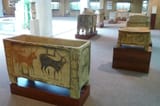Search Results
6/18/2025, 7:19:35 AM
>>507823334
>In Greco-Roman Egypt, Geb was equated with the Greek titan Cronus, because he held a quite similar position in the Greek pantheon, as the father of the gods Zeus, Hades, and Poseidon, as Geb did in Egyptian mythology.
I misremembered, I was thinking of Nut (not Geb).
>At the same time, [Nut] was considered the mother of the stars. It was believed that the sun disappeared in her mouth in the evening, to travel through her body at night and reappear in the morning in her bosom in the east. In the eternal cycle, the stars also wandered through her body during the day. This metaphor is the origin for the designation of Nut as a "sow who eats her piglets". Despite this epithet, the goddess was seen as very positive.
(Nonetheless, in Hesiod's Theogony, Gaia (as the underworld) does "eat" the Titans so Cronus cannot kill them.)
Strabo the Geographer says about Crete:
>Staphylos says that the Dorians occupy the region towards the east, the Kydones the western part, the Eteocretans the southern, whose town is Prasos, where the temple of Diktaian Zeus is; and that the Eteocretans and Kydones are probably indigenous, but the others incomers
They also discovered Egyptian statues in the Cydonian section and Carian writing in Memphis, Egypt.
>In Greco-Roman Egypt, Geb was equated with the Greek titan Cronus, because he held a quite similar position in the Greek pantheon, as the father of the gods Zeus, Hades, and Poseidon, as Geb did in Egyptian mythology.
I misremembered, I was thinking of Nut (not Geb).
>At the same time, [Nut] was considered the mother of the stars. It was believed that the sun disappeared in her mouth in the evening, to travel through her body at night and reappear in the morning in her bosom in the east. In the eternal cycle, the stars also wandered through her body during the day. This metaphor is the origin for the designation of Nut as a "sow who eats her piglets". Despite this epithet, the goddess was seen as very positive.
(Nonetheless, in Hesiod's Theogony, Gaia (as the underworld) does "eat" the Titans so Cronus cannot kill them.)
Strabo the Geographer says about Crete:
>Staphylos says that the Dorians occupy the region towards the east, the Kydones the western part, the Eteocretans the southern, whose town is Prasos, where the temple of Diktaian Zeus is; and that the Eteocretans and Kydones are probably indigenous, but the others incomers
They also discovered Egyptian statues in the Cydonian section and Carian writing in Memphis, Egypt.
6/17/2025, 1:00:03 AM
>>17766698
>>17766804
>>17766832
1. Zeus is Asian, not European (From Lydian "Lefs", or the liver-eating Eagle from Colchis/Georgia, except for Minoan "Bull Zeus" (who is Mal'ak the Grim Reaper) and the Dodonian "Tree Zeus")
2. Aphrodite is Asian, not European (Generally considered to be of Phoenician origin)
3. Apollo is Asian, not European (From Assyrian Asshur or Sumerian Marduk)
4. Poseidon is African, not European (From a Libyan horse-headed deity. His connection to winds was taken from Homeric Aeolus the Ram god of the Winds (itself from Egyptian Banebdjedet))
5. Demeter is Asian, not European (from Lydian "Lametrus")
6. Dionysus is Asian, not European (From Lydian "Pakish")
7. Artemis is Asian, not European (from Lydian "Artemus")
Hephaestus, Hestia, and Athena are "possibly native to Europe", but there are reasons to believe that Hephaestus is from Ugaritic Kothar-wa-Kosis, that Hestia is from Scythian Tapiti, and that Athena is from Ugaritic Anat.
The only "probably native to Europe" major Greek deities are Aidoneus (Hades), Hermes, Ares, Rhea, and Hera.
>>17766804
>>17766832
1. Zeus is Asian, not European (From Lydian "Lefs", or the liver-eating Eagle from Colchis/Georgia, except for Minoan "Bull Zeus" (who is Mal'ak the Grim Reaper) and the Dodonian "Tree Zeus")
2. Aphrodite is Asian, not European (Generally considered to be of Phoenician origin)
3. Apollo is Asian, not European (From Assyrian Asshur or Sumerian Marduk)
4. Poseidon is African, not European (From a Libyan horse-headed deity. His connection to winds was taken from Homeric Aeolus the Ram god of the Winds (itself from Egyptian Banebdjedet))
5. Demeter is Asian, not European (from Lydian "Lametrus")
6. Dionysus is Asian, not European (From Lydian "Pakish")
7. Artemis is Asian, not European (from Lydian "Artemus")
Hephaestus, Hestia, and Athena are "possibly native to Europe", but there are reasons to believe that Hephaestus is from Ugaritic Kothar-wa-Kosis, that Hestia is from Scythian Tapiti, and that Athena is from Ugaritic Anat.
The only "probably native to Europe" major Greek deities are Aidoneus (Hades), Hermes, Ares, Rhea, and Hera.
Page 1

